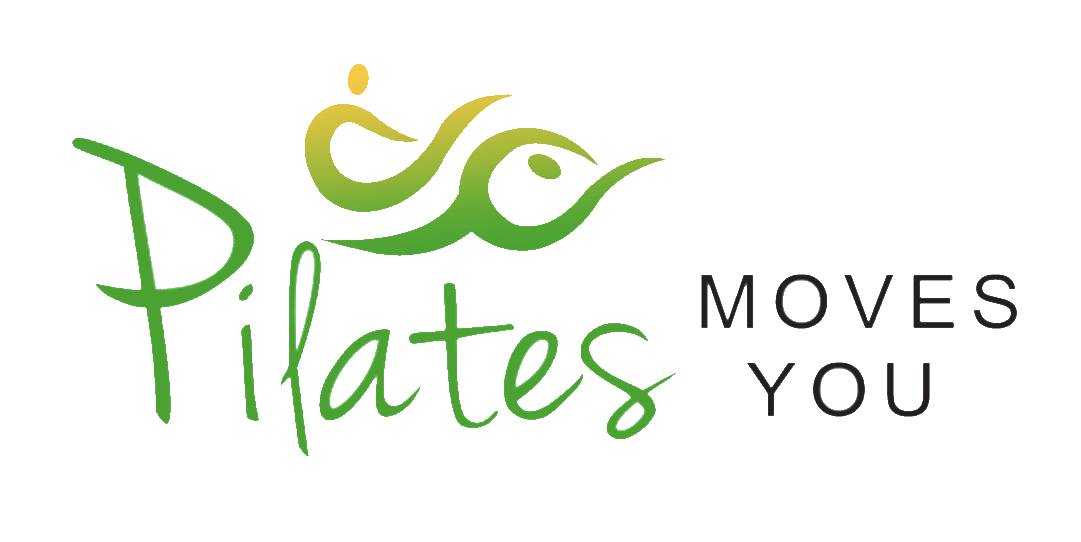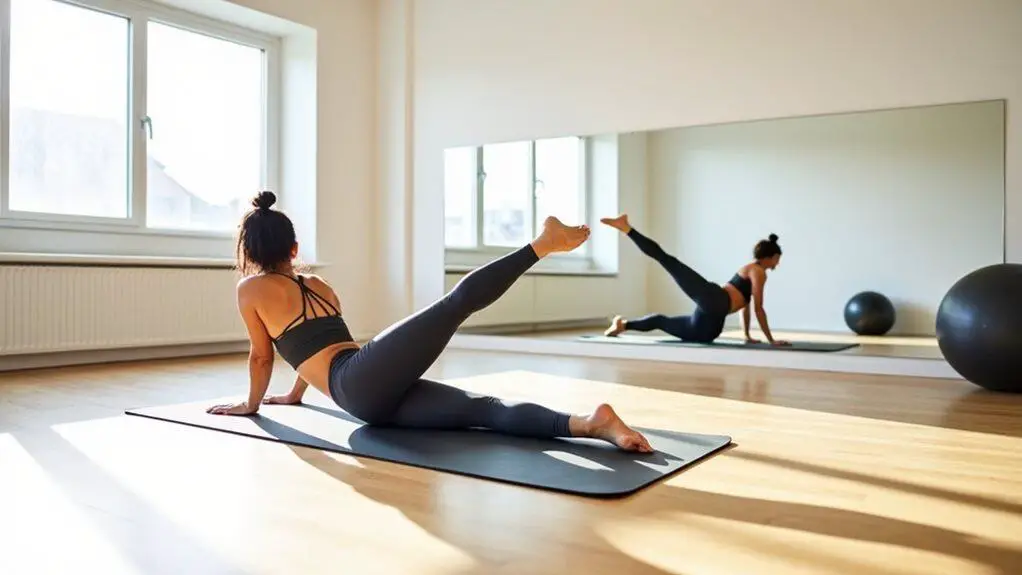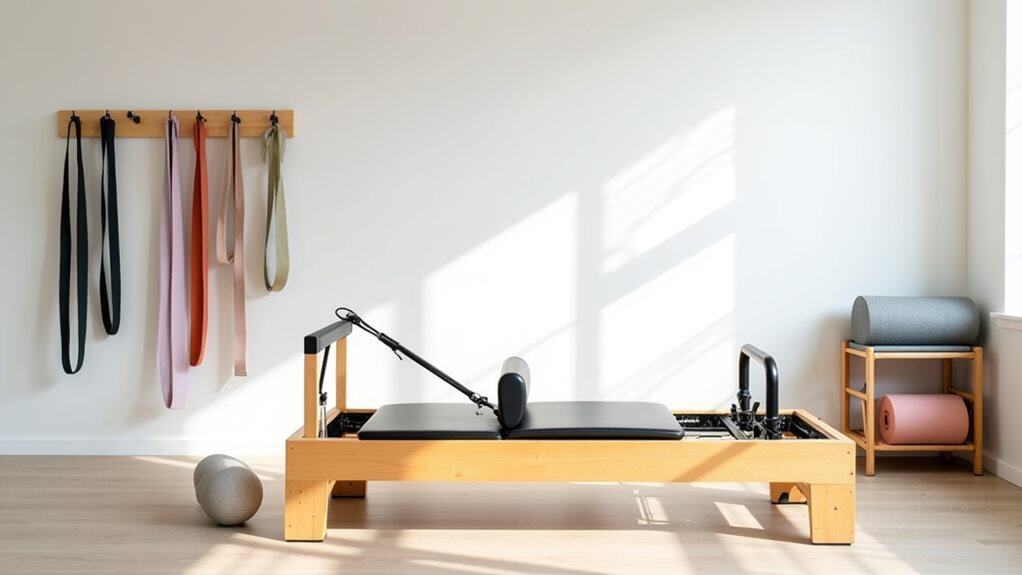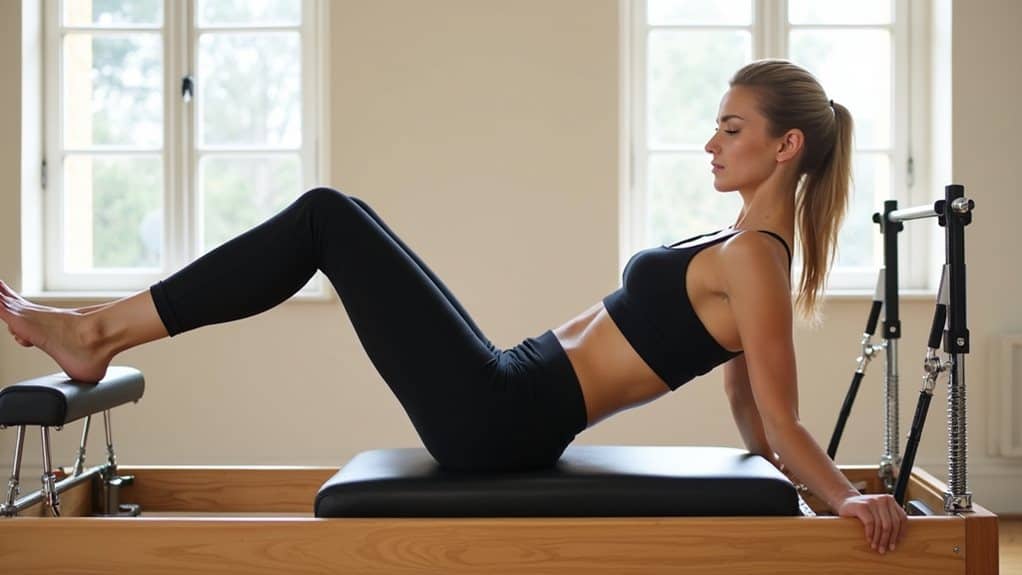As an athlete, you understand the importance of flexibility, strength, and balance for optimal performance. That’s where Pilates comes in. Pilates for athletes has become increasingly popular in recent years as more athletes discover the benefits of incorporating Pilates into their training regimen.
Pilates is a form of exercise that focuses on precision, controlled movements and breathing techniques to improve core strength, flexibility, and overall body awareness. Flexibility is crucial for athletes, as it can improve agility and reduce the risk of injury. Pilates for athletes specifically targets flexibility training as well as core strength, balance and coordination, helping to enhance athletic performance and prevent injury.
What is Pilates?
Pilates is a form of exercise that focuses on improving core strength, flexibility, balance, and coordination. It is a low-impact form of exercise that can be performed on a mat or with specialized equipment, such as a reformer.
The principles of Pilates include concentration, control, centering, flow, precision, and breath. Pilates is meant to be performed with mindfulness and attention to proper form and technique.
Pilates is a great way to improve overall fitness and can be beneficial for athletes looking to enhance their performance. By focusing on core strength and flexibility, Pilates can help athletes develop better balance, coordination, and control in their movements.
Types of Pilates Exercises
Pilates is a versatile form of exercise that can be done in a variety of ways, depending on your goals and preferences. There are several types of Pilates exercises, including mat Pilates and reformer Pilates, each with its own unique benefits.
Mat Pilates
Mat Pilates is a type of Pilates that is done on a mat, using your own body weight as resistance. It is a great option for those who want to improve their flexibility, balance, and core strength without any equipment. Mat Pilates exercises can be done anywhere, making it a convenient option for athletes who are always on the go.
Some common mat Pilates exercises include the hundred, rolling like a ball, and the single leg circle. These exercises target various muscle groups, including the abs, glutes, and legs.
Reformer Pilates
Reformer Pilates is a type of Pilates that is done on a piece of equipment called a reformer. The reformer is a bed-like frame with a flat platform that moves back and forth on wheels. Springs and ropes provide resistance as you move the platform with your body weight, creating a challenging and effective workout.
Reformer Pilates is great for athletes who want to improve their flexibility, strength, and balance in a low-impact way. It can help improve posture, increase muscle tone, and improve overall athletic performance.
Some common reformer Pilates exercises include the long box, the footwork, and the elephant. These exercises target various muscle groups, including the abs, arms, and legs.
Pilates for Flexibility Training
Flexibility is an essential component of athletic performance and injury prevention. Pilates is an excellent form of exercise to improve flexibility for athletes. Pilates exercises focus on stretching the entire body, including the muscles that are often neglected during traditional strength training.
Pilates stretches can help athletes increase their range of motion, which is important for improving athletic performance. A wider range of motion allows athletes to move more freely, improving their speed, agility, and overall performance. Pilates stretches also help prevent muscle imbalances, which can lead to injury.
Unlike static stretching, which involves holding a position for a prolonged period, Pilates stretches involve dynamic movement. This type of stretching is more effective for improving flexibility, as it stretches the muscles through a full range of motion.
Pilates Stretches
There are many Pilates stretches that can be used for flexibility training. These stretches can be adapted to target specific muscle groups and can be performed on a mat or a reformer.
| Stretch | Targeted Muscle Group |
|---|---|
| Single Leg Stretch | Hamstrings and hip flexors |
| Spine Stretch Forward | Spinal erectors and hamstrings |
| Swan Stretch | Chest and hip flexors |
| Mermaid Stretch | Quadriceps and hip flexors |
These Pilates stretches are just a few examples of the many exercises that can be used for flexibility training. It is recommended that athletes work with a certified Pilates instructor to ensure proper form and technique.
Overall, Pilates is an excellent form of exercise for improving flexibility in athletes. Pilates stretches can increase range of motion, prevent injury, and improve overall athletic performance.
Pilates for Core Strength
Core strength is essential for athletic performance as it provides stability for movements and helps prevent injuries. Pilates exercises are a great way to improve core strength, as they target the deep muscles of the abdomen, back, and pelvic floor.
One of the key principles of Pilates is centering, which emphasizes the use of the core muscles to initiate movement. By focusing on the core, Pilates exercises can help athletes develop a strong and stable core that can support them during their sport-specific movements.
Some of the best Pilates exercises for core strength include:
| Exercise Name | Description |
|---|---|
| The Hundred | A classic Pilates exercise that involves lifting the head and shoulders off the mat while pumping the arms up and down. |
| The Plank | A core strengthening exercise that involves holding a straight-arm plank position for several seconds. |
| The Teaser | A challenging exercise that involves lifting the legs and arms off the mat while balancing on the tailbone. |
By incorporating Pilates exercises into their training routine, athletes can develop a strong and stable core that can improve their athletic performance and reduce the risk of injuries.
Pilates for Balance Training
Balance is a key component of athletic performance, and Pilates is an excellent way to improve it. By targeting specific muscles and focusing on controlled movements, Pilates can help athletes improve their balance and stability.
One of the ways Pilates improves balance is by targeting the core muscles. A strong core is essential for maintaining balance and stability during dynamic movements, such as changing directions or jumping. Pilates exercises such as the plank and the teaser are great for building core strength and improving balance.
In addition to core exercises, Pilates also includes movements that challenge balance and coordination. For example, the single-leg balance and the standing leg circles target the leg muscles and challenge the body’s ability to maintain balance. These exercises can be modified to make them more challenging as athletes progress in their training.
Using Pilates for Sport-Specific Movements
Pilates exercises can be modified to target sport-specific movements and improve balance in those movements. For example, a tennis player could use Pilates exercises that mimic the movements of a backhand swing or a serve. The exercises would challenge the athlete’s balance and stability in those specific movements, helping to improve overall athletic performance on the court.
Similarly, a basketball player could use Pilates exercises that focus on lateral movements and quick changes of direction. These exercises would help the athlete maintain balance and control during these specific movements, improving their overall performance on the court.
Pilates for Injury Prevention
Injuries are a common occurrence in sports, but they can be prevented with proper training and conditioning. Pilates is an effective form of injury prevention for athletes, as it improves flexibility, core strength, balance, and coordination.
Research has shown that Pilates can reduce the risk of injury in athletes, particularly in high-risk sports such as football, soccer, and basketball. By strengthening the muscles around the joints and improving flexibility, Pilates helps to reduce the impact of sudden movements and decreases the risk of strains and sprains.
For athletes who have already suffered an injury, Pilates can also be used as a form of rehabilitation. The controlled movements and low-impact exercises help to rebuild strength and flexibility without placing too much stress on the injured area.
One of the key benefits of Pilates for injury prevention is its focus on proper alignment and body mechanics. By improving posture and balance, athletes can reduce the risk of overuse injuries, such as tendonitis and stress fractures. Pilates also helps to improve proprioception, which is the body’s ability to sense its position in space. This is important for sports that require quick changes of direction or balance, such as gymnastics or figure skating.
| Benefits of Pilates for Injury Prevention: | Examples of Pilates Exercises: |
|---|---|
| Reduced risk of strains and sprains | Leg circles, spine stretch, supine hamstring stretch |
| Improved flexibility and range of motion | Swan, single leg stretch, spine twist |
| Better posture and body mechanics | Roll up, pelvic tilt, shoulder bridge |
| Increased proprioception and balance | Tree, single leg circles, plank |
By incorporating Pilates into their training routine, athletes can reduce the risk of injury and improve their overall performance on the field or court. Consult with a qualified Pilates instructor to learn more about how Pilates can benefit your specific sport and training needs.
Pilates for Rehabilitation
Aside from injury prevention, Pilates can also be used to aid in injury recovery. Whether recovering from a minor sprain or a major surgery, Pilates can be adapted to suit an athlete’s specific needs and limitations.
When properly executed, Pilates exercises can target specific areas of the body, such as the lower back or knees, helping to strengthen and support these vulnerable areas.
| Pilates Exercises for Rehabilitation | Description |
|---|---|
| Swan Dive | This exercise targets the lower back and can help with recovery from back injuries. It involves lying on your stomach and lifting your chest and arms off the ground while keeping your legs and pelvis in contact with the mat. |
| Knee Stretches | Knee stretches can be adapted to suit different levels of knee injury severity. This exercise involves kneeling on a reformer and gently moving the carriage back and forth with your legs, working to increase range of motion and build strength. |
| The Bridge | This exercise targets the glutes and can help to improve hip stability and prevent knee injuries. It involves lying on your back with your knees bent and lifting your hips off the ground while engaging your core. |
By incorporating Pilates into their rehabilitation program, athletes can regain strength and mobility faster than with traditional physical therapy alone. Pilates’ low-impact nature also makes it a great option for those with joint or mobility issues.
Additional Notes:
When it comes to rehabilitation, it is important to consult with a qualified Pilates instructor or physical therapist who can design a program tailored to your individual needs and goals. It’s also important to note that Pilates should not be used as a substitute for medical treatment and should always be practiced under the supervision of a professional.
Pilates for Cross-Training
When it comes to improving overall athletic performance, cross-training is essential. Cross-training involves engaging in various forms of exercise to supplement your primary sport or training routine. Pilates is an excellent form of cross-training for athletes, as it focuses on improving core strength, balance, flexibility, and coordination.
By incorporating Pilates into their training regimen, athletes can benefit from improved performance in their primary sport. Pilates can also reduce the risk of injury and aid in injury rehabilitation.
How can Pilates complement other forms of training?
Pilates can be used to complement other forms of training by focusing on specific areas that may not be targeted by other exercises. For example, weightlifting primarily targets muscle strength, while Pilates focuses on core strength and balance. By incorporating Pilates into a weightlifting routine, an athlete can improve their overall muscle function and reduce the risk of injury.
Similarly, long-distance runners can benefit from Pilates by improving their core stability and balance, which is essential for maintaining proper running form and reducing impact on joints. Pilates can also be used to supplement sport-specific training by improving overall body awareness and coordination.
How often should athletes do Pilates?
The frequency of Pilates sessions for athletes depends on their individual training regimen and goals. However, it is recommended that athletes engage in Pilates at least once a week to see noticeable improvement in their athletic performance. Some athletes may choose to incorporate Pilates into their daily routine for maximum benefit.
It is important to note that Pilates should not replace an athlete’s primary training regimen, but rather supplement it. It is best to consult with a Pilates instructor or a certified athletic trainer for guidance on incorporating Pilates into a training routine.
Pilates for Mental Focus
While many athletes focus on physical training, mental focus is just as important when it comes to athletic performance. Pilates can help improve mental clarity, concentration and mindfulness, enabling athletes to perform at their best.
One of the key principles of Pilates is breathing, which can help athletes stay calm and focused during competition. By focusing on deep, controlled breathing, athletes can reduce stress and anxiety, and perform at their best.
In addition to breathing, Pilates exercises can help athletes develop greater body awareness. By becoming more aware of their bodies and movements, athletes can improve their coordination, balance, and overall performance.
Try incorporating the following Pilates exercises into your training routine to enhance your mental focus:
| Pilates Exercise | Description |
|---|---|
| The Hundred | Lie on your back with your knees bent and feet flat on the floor. Lift your head, neck and shoulders off the floor and extend your arms by your sides, palms facing down. Begin pumping your arms up and down, inhaling for five pumps and exhaling for five pumps. Repeat for ten breaths. |
| The Teaser | Sit with your knees bent and feet flat on the floor. Slowly roll your spine down to the mat one vertebrae at a time, extending your arms overhead as you lower. Engage your core to roll back up to a seated position and reach your arms towards your toes. |
| The Plank | Begin in a push-up position, with your hands directly under your shoulders and your body in a straight line. Engage your core and hold for 30 seconds to one minute. |
By incorporating Pilates into their training routine, athletes can improve their mental focus, mindfulness and overall performance. Try these exercises and see the difference for yourself.
Benefits of Pilates for Athletes
Pilates is a highly effective form of training that can offer a wide range of benefits for athletes. In addition to improving flexibility, strength, and balance, Pilates can also help prevent injuries, aid in rehabilitation, and enhance mental focus. Here are some of the top benefits of Pilates for athletes:
| Benefit | Description |
|---|---|
| Improved Flexibility | Pilates stretches can help elongate muscles, making them more flexible and reducing the risk of injury. |
| Enhanced Core Strength | Pilates exercises target the deep core muscles, improving core strength and stability, which is essential for athletic performance. |
| Better Balance and Coordination | Pilates can help improve balance and coordination, which is important for sport-specific movements and injury prevention. |
| Injury Prevention | Pilates can reduce the risk of injury by improving flexibility, core strength, balance, and coordination. |
| Rehabilitation | Pilates can be used as a form of injury rehabilitation, with specific exercises tailored to aid in injury recovery. |
| Cross-Training | Pilates can complement other forms of training and be used for cross-training, leading to overall improved athletic performance. |
| Mental Focus | Pilates exercises can improve mental focus and mindfulness, leading to greater clarity and concentration during training and competition. |
Overall, incorporating Pilates into an athlete’s training routine can lead to significant improvements in performance and reduced risk of injury. Whether used for flexibility training, core strength, rehabilitation, or mental focus, Pilates offers numerous benefits that can help athletes achieve their goals.
Pilates for Athletes FAQs
Here are some commonly asked questions about Pilates for athletes:
Is Pilates suitable for all athletes?
Yes, Pilates is suitable for athletes of all ages and abilities. Whether you’re a professional athlete or a weekend warrior, Pilates can help improve your athletic performance and reduce your risk of injury.
How often should athletes do Pilates?
The frequency of your Pilates workouts will depend on your individual goals and training schedule. Some athletes may benefit from doing Pilates once or twice a week, while others may want to incorporate it into their daily routine. Your Pilates instructor can help you develop a personalised plan that works for you.
What types of Pilates exercises are best for athletes?
There are many types of Pilates exercises that can benefit athletes, including exercises that focus on core strength, flexibility, balance, and coordination. Some common Pilates exercises for athletes include the Pilates roll-up, single leg circles, and the Pilates swan.
Can Pilates help with injury prevention?
Yes, Pilates can help reduce the risk of injury by improving flexibility, core strength, balance, and coordination. By addressing these key areas, Pilates can help athletes prevent common sports injuries and stay healthy and active for longer.
Is Pilates a good form of cross-training for athletes?
Yes, Pilates is an excellent form of cross-training for athletes. By complementing other forms of training, Pilates can help improve overall athletic performance and reduce the risk of injury. Many professional sports teams and athletes incorporate Pilates into their training programs.




